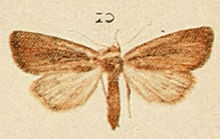
The pine beauty is a moth of the family Noctuidae. It is a common species of pine woods in Europe. The distribution area extends from Portugal to western Siberia, the Caucasus and Asia Minor. In the north it extends to the Arctic Circle, in the south it is found in Ceuta in Northern Africa in and southern Italy.

The bright-line brown-eye is a moth of the family Noctuidae. The species was first described by Carl Linnaeus in his 1758 10th edition of Systema Naturae. It is a common species throughout Europe, but is also found in North Africa, temperate North Asia and Central Asia, Asia Minor, Syria, and Turkestan, northern India, China, Korea and Japan.

The common Quaker is a moth of the family Noctuidae first described by Johan Christian Fabricius in 1775. Some authors prefer the synonym Orthosia stabilis(Denis & Schiffermüller, 1775). It is distributed throughout Europe and is also found in Turkey, Israel, Transcaucasia, Russia and eastern Siberia.

The Hebrew character is a moth in the family Noctuidae. The species was first described by Carl Linnaeus in his 1758 10th edition of Systema Naturae. It is found throughout Europe.
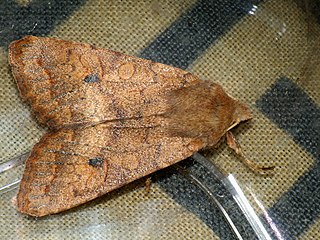
Agrochola circellaris, or The Brick, is a species of moth of the family Noctuidae. The species was first described by Johann Siegfried Hufnagel in 1766. It is distributed throughout most of Europe, Asia Minor and Armenia.
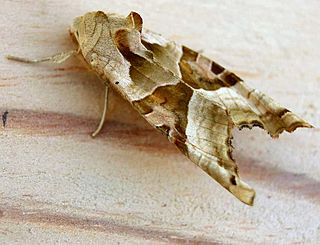
The angle shades is a moth of the family Noctuidae. The species was first described by Carl Linnaeus in his 1758 10th edition of Systema Naturae. It is distributed throughout Europe as far east as the Urals and also in the Azores, in Algeria, and in Asia Minor, Armenia, and Syria. It is strongly migratory.

The straw underwing is a species of moth in the family Noctuidae. The species was first described by Johann Siegfried Hufnagel in 1766. It is found from North Africa west through South Europe and Central Europe. In the north it is in parts of Ireland, Scotland, Sweden, Norway, Finland and Estonia. Further east the range stretches from southern Russia and Asia minor to the Caucasus.

Agrochola lota, the red-line Quaker, is a moth of the family Noctuidae. The species was first described by Carl Alexander Clerck in 1759. It is distributed throughout the whole of Europe except Scandinavia; in Armenia, Asia Minor, and east across the Palearctic to the Altai Mountains and western Siberia.It was introduced to Newfoundland. In the Alps, it rises at altitudes of just over 1500 metres.

Agrochola lychnidis, the beaded chestnut, is a moth of the family Noctuidae. The species was first described by Michael Denis and Ignaz Schiffermüller in 1775. It is distributed throughout the whole of Europe from Ireland to the Urals. It also occurs in western North Africa and Asia Minor.

Mythimna albipuncta, the white-point, is a moth of the family Noctuidae. The species was first described by Michael Denis and Ignaz Schiffermüller in 1775. It is distributed throughout Europe and one subspecies is found in Tunisia. It is also found in Asia Minor, Armenia, and Iran, and the northeastern United States.

Orthosia incerta, the clouded drab, is a species of moth of the family Noctuidae, found in Europe and Asia. The occurrence of the species extends through all European countries through the Palearctic to the Russian Far East and Japan. It is absent from northern Fennoscandia and in the Alps it occurs up to 2000 m above sea level.

Orthosia cruda, the small Quaker, is a moth of the family Noctuidae. It is found in Europe, Morocco, Algeria, Tunisia, Turkey, the Caucasus, Transcaucasia, Kazakhstan, Israel, Lebanon, Cyprus and Jordan.
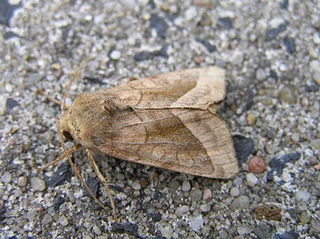
Hydraecia micacea, the rosy rustic, is a moth of the family Noctuoidea. It is found across the Palearctic realm from Ireland to Siberia. It reaches Japan and is introduced to eastern USA, Quebec and Ottawa.
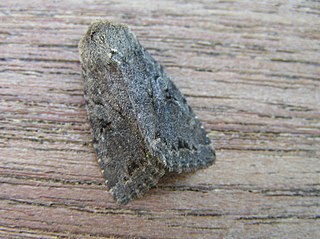
Fissipunctia ypsillon, the dingy shears, is a species of moth of the family Noctuidae. It is found in the Palearctic realm.
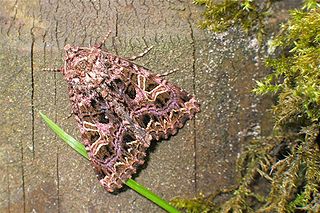
Sideridis rivularis, the campion, is a species of moth of the family Noctuidae. It is found in from the northern part of the Iberian Peninsula, through the whole of Europe. To the east, it is found in Central Asia and Siberia, up to Manchuria. To the south, it is found in the Mediterranean Sea region and parts of Asia Minor. In the Alps, it is found at up to 1,600 metres above sea level.

Agrochola macilenta, the yellow-line Quaker, is a moth of the family Noctuidae. The species was first described by Jacob Hübner in 1809. It is found in Europe and in Asia Minor.

Mythimna straminea, the southern wainscot, is a moth of the family Noctuidae. The species was first described by Georg Friedrich Treitschke in 1825. It is found in the western parts of the Palearctic realm, including Morocco, Europe, Turkey, the Caucasus, Israel, and Lebanon.

Agrotis ripae, the sand dart, is a moth of the family Noctuidae. The species was first described by Jacob Hübner in 1823. It is found in western Europe and North Africa and extends east across the Palearctic to steppe areas in Russia, Mongolia and Siberia.

Denticucullus pygmina, the small wainscot, is a moth of the family Noctuidae. It is found in most of Europe, ranging from northern Spain, through Portugal as far north as Finland. In the east it is found across the Palearctic to the Russian Far East and western Siberia. It is also found in North Africa, Turkey, the Caucasus region and northern Iran.
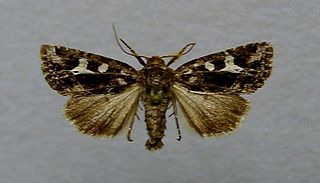
Celaena haworthii, or Haworth's minor, is a moth of the family Noctuidae. The species was first described by John Curtis in 1829. It is found from the British Isles and France through northern Europe including Scandinavia, east to the Urals and across the Palearctic to Siberia and up to the Pacific Ocean.
